Content
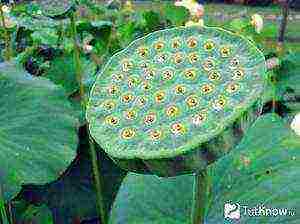 The lotus is an amazing flower. From antiquity to the present day, it carries a mystical meaning for peoples professing Buddhism. This is not surprising, the bud can reach from 10 cm to 30 cm in diameter, and the blossoming flower pleases the eye for only 4 days.
The lotus is an amazing flower. From antiquity to the present day, it carries a mystical meaning for peoples professing Buddhism. This is not surprising, the bud can reach from 10 cm to 30 cm in diameter, and the blossoming flower pleases the eye for only 4 days.
He has very delicate petals and a very strong aroma... An essential oil is produced from lotus seeds, which is as expensive as rose oil.
In nature, there are only two species of this beautiful plant: Indian and yellow. Breeders don't stop working over the breeding of new varieties of this flower... And now it has become possible for flower growers and amateurs to grow lotus at home. For this existence of this plant, the constant availability of clean water is necessary and care is very important.
How to grow a lotus?
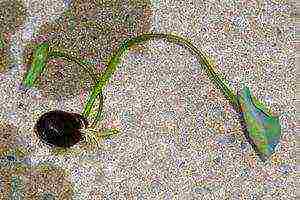 There are two ways to propagate this flower:
There are two ways to propagate this flower:
- root system;
- seeds.
Algorithm for growing a lotus by dividing the rhizome:
- Extract the tuber that has faded from the soil;
- Dry it, make sure it is healthy, there is no powdery mildew and rot on it;
- Cut the tuber into pieces so that one sprout primordium is present;
- Plant in prepared soil covered with water.
Growing this plant in this way has its pros and cons. The plus is that the plant begins to bloom faster and propagation by the root process is quite simple. The downside is that plants obtained in this way are less adaptable to other conditions. Therefore, for those who are just starting to plant lotus at home, it is better to grow it from seeds.
Growing lotus from seeds at home
It includes the preparation of planting material - seeds, a container where seedlings will need to be grown, containers for transplanting a lotus.
Selection and preparation of lotus seeds
 This point should be taken seriously enough. Carefully study the declared parameters regarding the size of the flower before buying lotus seeds, since the names of the hybrids may coincide, but length of leaves, roots and diameter of buds can be very different. Seeds remain viable for up to 100 years. However, the fresher the seeds are, the better they germinate.
This point should be taken seriously enough. Carefully study the declared parameters regarding the size of the flower before buying lotus seeds, since the names of the hybrids may coincide, but length of leaves, roots and diameter of buds can be very different. Seeds remain viable for up to 100 years. However, the fresher the seeds are, the better they germinate.
Lotus seeds are dark large oblong nuts, 1.5 cm long, up to 1 cm wide. They are very hard. Therefore, before germination, it is necessary to carry out the scarification procedure. In other words, it means breaking the waterproof shell of the seeds, otherwise the lotus seeds will simply rot.
One side of the seed is pointed and the other is blunt. From the blunt side, you need to open the outer shell so as not to damage the amniotic membrane. A file or sandpaper is suitable for this. The cutting process is time consuming.
The prepared planting material is placed in a plastic or glass container. It must be filled with settled water, since chlorinated water is not suitable for germinating lotus seeds. The water temperature should be from +20 to +25 degrees. The water should be changed twice a day. After about 5-7 days, the root and the first sprout will appear from the seed. A characteristic sign that the seeds have swollen and germinate will be their sinking to the bottom of the container. Those seeds that continue to float are likely to have lost their germination.
After 2-3 weeks, the sprouted shoots from the container are transplanted into a large container or directly into the reservoir. At the same time, the height of the seedlings reaches about 15 cm.
Landing algorithm
You should take an aquarium or a plastic pot without holes in the bottom, or another container with a volume of 10 to 20 liters, fill the bottom with soil. Peat can be used as soil. The sprouts should be planted in it to a depth of 6-8 cm. In this case, it is imperative that the leaves float on the surface of the water. Sprinkle the soil with a thin layer of sand, then a layer of pebbles, fill with water. The ratio of soil to water in the container should be 2: 1. The container is placed in a bright and warm place. And then it all depends on the quality of plant care.
Conditions for keeping lotus
 In vivo lotus grows in tropical climates... Therefore, the temperature regime should be at least +25 and not higher than +30 degrees. The plant is afraid of drafts. Requires a lot of light. High relative humidity is required. Often, to provide moisture, whole compositions are created when a small fountain is placed in the reservoir where the flower grows to spray the leaves of the plant.
In vivo lotus grows in tropical climates... Therefore, the temperature regime should be at least +25 and not higher than +30 degrees. The plant is afraid of drafts. Requires a lot of light. High relative humidity is required. Often, to provide moisture, whole compositions are created when a small fountain is placed in the reservoir where the flower grows to spray the leaves of the plant.
The thickness of the soil in the container can be at least 4 cm, and the depth of the water above it is at least 50 cm. For round containers, the sprout is planted directly in the center. If the plant is planned to be transplanted into a pond, then its depth should be at least one and a half meters.
Clean water should be added to the vessel as needed and care should be taken that the water does not become cloudy. Since it can be a breeding ground for the appearance of pests and the spread of diseases in the plant.
For the winter, the water from the container is partially drained, the bottom is covered with foam or moss so that the lotus does not freeze and die. And they clean it up in a dark place until spring. Until sunny and warm days come.
Lotus flowers, which are grown from seeds, appear in 2-3 years. The older the plant, the larger the buds it gives. While maintaining constant optimal conditions for temperature and illumination, it can bloom all year round.
>
 The lotus is a valuable decorative culture that occupies an important place in world culture and religion. The owners of private plots are engaged in the cultivation of this perennial amphibian shrub to decorate decorative reservoirs. The domestic lotus flower is planted with seeds or tubers and has the same care difficulties as the wild one - not adaptable to cold weather. Therefore, in the conditions of the Russian Federation, it is not easy to grow it.
The lotus is a valuable decorative culture that occupies an important place in world culture and religion. The owners of private plots are engaged in the cultivation of this perennial amphibian shrub to decorate decorative reservoirs. The domestic lotus flower is planted with seeds or tubers and has the same care difficulties as the wild one - not adaptable to cold weather. Therefore, in the conditions of the Russian Federation, it is not easy to grow it.
Description of lotus varieties
The flower has been cultivated for so long that it itself has already become part of the religion of Buddhism. In addition to its cultural and decorative value, the lotus has nutritional value. Various parts of the shrub are the basis of exotic dishes. From a botanical point of view, lotuses make up an extensive group of perennial plants of the lotus family. There are only two pure wild species:
- Indian nut-bearing, native to Asia. The growing area also covers the Amur River. Has nut-like seeds.

Nut lotus
- Yellow, North American. It has wide emergent leaves, about 70 cm in diameter. The leaves have a shiny waxy coating.
Attention! The decorative plus of the lotus is also the ability to change the position of the flower following the movement of the sun across the sky.
Also, breeders have bred several hybrids. All lotuses have a thick root, which is submerged in the underwater soil and takes out nutrients from there. The stems adapted to the aquatic environment are also completely submerged in the soil. Flexible long deciduous petioles of the plant stretch to the surface of the water.
There are three types of lotus leaves:
- underwater;
- floating;
- surface.
The flower opens for three days. During this time, some varieties even change the color of the petals. Flowers appear at different points on the leaves.
Height - up to 180 cm, in dwarf species - up to 30 cm. Other features - the shape and length of leaves and flower cups - differ depending on the hybrid. Lotus is extremely heat demanding. For flowers to appear, the plant needs 2-3 months with a stable temperature within + 23 ... + 29 ° С.In colder climates, perennials will not bloom, and in hotter and drier climates, too.
Attention! The peculiarity that became the basis of the mythologization of the lotus in ancient culture is that at night, inside the closed cup of the flower, heat is maintained at about 37 ° C. Therefore, the lotus is so fond of pollinating insects.
How to grow a lotus from seed
Growing at home from seed allows the flower to adapt in a less than suitable climate. Such plants are more resilient to drought or cold snaps. First you need to choose the right planting material. To have a chance of success, you must have tough black nuts with the following parameters:

Lotus seeds
- dimensions - approximately 1x1.5 cm;
- pericarp - strong woody.
The seed must first be scarified, filed with coarse sandpaper from a blunt end. Next, find a container - a transparent container: 90-120 cm in diameter, 25-30 cm deep. For dwarf varieties, you can take containers of a smaller volume. Do not use wavy or square containers. Young shoots of the plant can break, leaning against the corner. This will cause significant harm to the lotus.
After that, you can start landing:
- Take a small, shallow jar first. Fill it halfway with warm water (+ 18 ... + 25 ° C).
- Drop the seeds and wait. At room temperature, the first root will appear on the 5-6th day.
- 2-3 weeks after germination, the lotus seeds can be transferred to a large container. Deepen them into the peat 6-7 m. The leaves should remain above the water. To prevent the root tuber from floating up during the procedure, you can press it down with a flat stone.
- Watch out for the growth of the deciduous mass - water must be added regularly so that floating leaves remain exactly on the surface of the water. If you drown the leaves, the lotus will die.
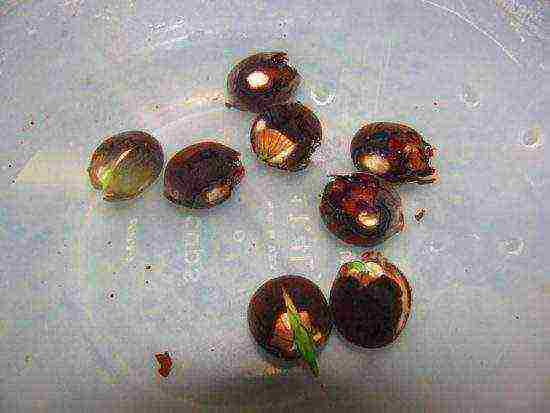
Germinating seeds in water
- The container should be in a sunny and warm place.
- Then the flower can be simply transferred to a summer reservoir or left in the format of a houseplant. The optimal time for final transfer is 5-6 leaves. Previously, a little earth or gravel should be poured over the tuber of the plant.
Features of lotus care
The main thing is to maintain optimal conditions for flower development:
- sufficient water level;
- abundance of the sun;
- temperature not lower than + 20 ° С and not higher than + 29 ° С.
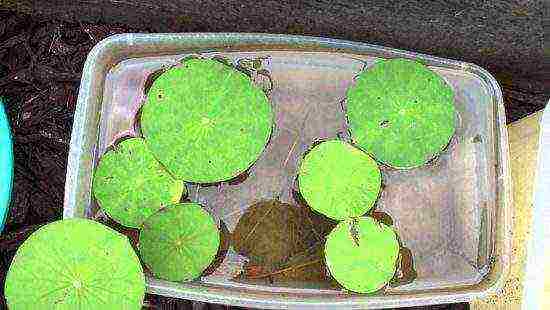
Growing a lotus in a container
Domestic gardeners have gotten used to placing the lotus in ponds directly in containers in order to hide the flower behind home walls with a cold snap and take it out again after the end of the frost. You can also leave the lotus in the pond by simply covering it with foam in the fall. For storage indoors, part of the water must be poured out of the pot, and the plant itself must be insulated with moss.
The pot should be in a cool place. Watering and disturbing the lotus in every way is impossible. Make sure that the temperature in the storage area does not rise in the spring and the plant does not come to life ahead of time. In open reservoirs or large pots for an adult plant, it is enough to observe simple conditions so that the plant does not wither:
- ground level - from 3.5 cm;
- the thickness of the water layer is at least half a meter;
- placing the rhizome in the center of the container.
The lotus is a target for habitual garden dwellers - caterpillars or aphids. Insects can simply be washed off with water. It is important to do this in the morning. You can also use special drugs.
Be prepared that even with perfect care, the flowers will not appear for a long time, and green "pancakes" will simply float above the surface. Lotus owners wait 2-3 years for the first flower. After wilting and dying off of the inflorescence, a seed capsule forms in its place.
Growing a lotus from seeds: video
Lotus is an excellent amphibian and perennial bush type plant. The seeds of the plant have medicinal properties and are used in the creation of numerous decoctions, tinctures, poultices, etc.The European climate with rather harsh winters becomes a kind of obstacle to the normal cultivation of plants in our country. But, in this article we will talk about how to independently, at home, carry out the process of growing a lotus from seeds. Today there are two main ways of growing a plant:
- With the help of the rhizome - the process of division;
- Planting seeds (previously properly germinated and prepared).
Growing lotus seeds at home
This method is ideal for our area, since it is in this way that the aspects of adaptation of the plant to the European area can be ensured. Note that a lotus sprouted from seeds is much more resistant, it perfectly tolerates summer droughts, and even the negative effects of low temperatures.

In order for the germination to be correct and of high quality, you need to select the appropriate seeds. Outwardly, they look like nuts (large enough), always black. The coating is very hard, the height is no more than 1.5 cm, and the seed diameter is no more than a centimeter.
In order for the seed to germinate, it must be scarified.
Germination of a plant:
- From the blunt end, where there is a hole in the seed, the hard cover is filed. You can use sandpaper type, which will help to quickly rid the fruit of strong protection;
- After cleaning, you will need to take a sufficiently shallow dish. It is best to use a glass cup, but a plastic cup will work as well. The container is filled with warm water, no more than eighteen degrees;
- The seeds are immersed in warm water, after which, it remains only to wait for the sprouts to "hatch";
- After two to three weeks, a sprouted lotus is formed, it will need to be transplanted;
- The transplant is carried out either in a summer reservoir in the country, or in a regular pot for indoor plants;
- Immediately, earth or peat is poured into the pot, after which the surface is filled with water. Remember that the water must cover the planting soil by at least 10 cm. At the same time, you need to make sure that the leaves of the plant are on the surface;
- The seeds of the plant are deepened by the rhizome seven centimeters into the water (and into the ground), but the leaves must certainly be on the surface, in fact, they must float on the water;
- As the plant grows, you need to add water, make sure that the plant floats on the surface of the water;
- If the sprouts with leaves are drowned, then the plant instantly dies.
Important points of growing lotus
Pay attention to the fact that it is the right care that ensures the rapid development of the plant. After two years, you will already have the first flowers, over time, a box with seeds will form in place of the flower. Water should be added to the plant regularly, while heat and light are the main indicators of growth. Make sure the flower is getting the right amount of sunlight. Consider also that the plant can be taken out into the open air, but only after the end of the frost. Low temperature settings will adversely affect the plant and its development.
An equally important point in the development of a plant is the correct choice of capacity.
The tray grows well in large pots or in pits and open ponds. Experienced experts recommend that the soil layer be at least 3.5 cm for already mature plants, and the water level in this case should be at least half a meter. In the case of planting in a large pot, make sure that the rhizome is directly in the center.

If the lotus is left for the winter in an open reservoir, then it will certainly need to be insulated. In this case, ordinary foam is used, which is used to cover the reservoir, already from late autumn. At home, some of the water will need to be drained from the pot, and moss should be used as the main element of insulation. For the winter period, the plant is placed in a cool, fairly dark place. The most important thing in this case is the absence of abundant watering.In the spring, you need to make sure that the bush does not start active growth, this can damage development, therefore, with the onset of spring, the lotus is gradually "accustomed" to a warm and light atmosphere.
Remember, too, that like most plants, the lotus also has pests.
These can be caterpillars and aphids. In specialized stores, you can purchase products that are used to treat leaves from the negative effects of pests. When using such funds, make sure that the instructions are clearly followed, otherwise you can burn the leaves and destroy the plant.

Experts advise using a special pot structure when planting a plant. The planting mixture is poured onto the bottom, approximately 30-35 cm. On top, small pebbles are applied - no more than 10 cm, and about 10-30 cm of water (water covers the ground and pebbles). This structure of the planting site is optimal. The most important thing is to make sure that the lotus leaves are not completely submerged in water, otherwise this will lead to almost instant death of the plant.
The lotus is a beautiful plant that can be seen in some bodies of water. Its flower symbolizes beauty, innocence and tenderness. Also, this plant is often found in religion and culture of various countries. Therefore, it attracts attention with its uniqueness.
Most people will be interested in learning how to grow a lotus at home and if it can be done.
Interesting information about the plant
Lotus is an amazing perennial plant. There are interesting facts that can amaze any person. Especially if he does not have enough knowledge about this flower. For example, the seeds of a plant can be at the bottom of a reservoir for a long time and not germinate. This happens when there are adult flowers in the water. And only after they die, the process will start.

It is also interesting that the lotus has existed on Earth for a long period of time. They appeared in the era of the dinosaurs. And all this is due to the fact that their seeds are reliably protected by a hard shell. They can adapt to drought or prolonged exposure to water. It seems incredible, but it is a fact.
It is also interesting to know that there are two types of plants: yellow and Indian lotus. The first was found in North America and the second (as the name implies) in India. The lotus flower is considered a sacred symbol in Buddhism.
The petals of the plant are mainly white, yellow or pink. Moreover, the plant itself blooms for only 4 days. But the leaves of a plant can be both on the surface of the water and under it. Moreover, those leaves that are visible reach large sizes.
There are also such small plants. They were bred quite recently - these are miniature lotuses. Anyone can easily grow them at home in a small vessel.
Growing methods
There are two main ways to grow a lotus. It:
- using seeds;
- using the root.
The second method is less popular because it is more time consuming. Therefore, most people want to grow lotus at home from seeds. Although, of course, each person can choose the option that suits him best.

As you can see, the methods of growing lotus from seeds at home are varied. Let's consider them in more detail.
Growing a plant from seeds
Planting and growing a lotus from seed at home has its own characteristics. To begin with, you will need to prepare the seeds. This must be done, since they are distinguished by their strength and hardness. Therefore, with the help of a diamond file, small holes are made in them without affecting the embryo. This is scarification.
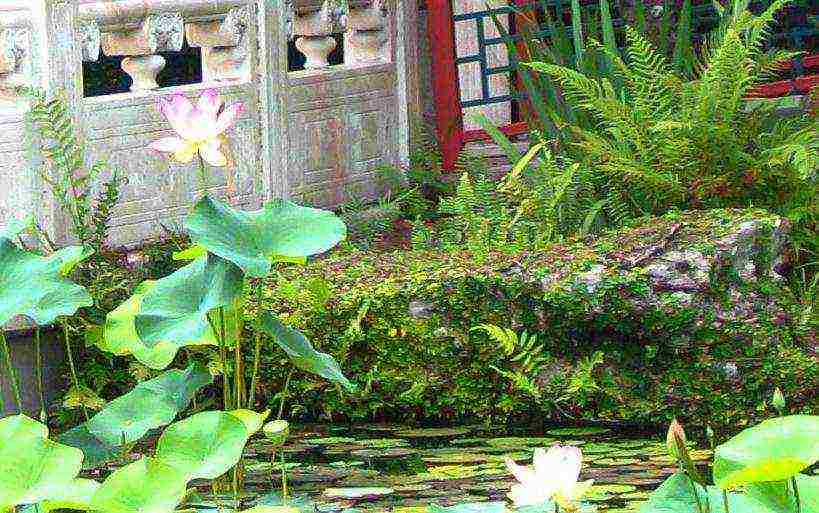
After that, you will need to place the seeds in a vessel with warm water. It is important that the water temperature is over 18 degrees.
Then you can watch how the first seedlings will appear in a few days. If everything goes well, then somewhere in 2-3 weeks it will be possible to plant seedlings.
Planting lotus
How to grow a lotus at home? After the seeds germinate, they should be planted in special containers. There should be two of them, and one should fit into the other. They should contain water at a level of 20 cm. In this case, the lotus will grow in such a container only for the first years, after which deeper dishes will be needed.
It will be necessary to put soil in the inner container. In this case, it is necessary to ensure that it is not damaged by pests. It is also important that the earth does not float when it is placed in the water. Therefore, it is best to arrange the soil with pebbles.
If it becomes a question of choosing a pot for a lotus, then it is better to take one that will not float. For example, ceramic may work.
If the water in the reservoir is warm, then you can immediately drop it here. But this should be done carefully - so that its leaves are above the water.

It is also worth noting that the aquarium is not the best place to grow these plants. This is due to the fact that the water here is often polluted, it will need to be changed constantly.
Growing with a root
To understand how to grow a lotus flower at home, you should consider the second method in more detail. Although less popular, it also has its advantages. For example, plants grown in this way bloom earlier.
To grow a plant in this way, it is necessary to separate one shoot from an adult flower. Then it will need to be placed in the ground with water. In this case, remember to change the water. It must be changed regularly. Use only settled water. Now everyone should understand how to grow a lotus at home in this way.
Growing features
It should be noted that the plant is able to tolerate winters well in the reservoir. But for this it is important that its bottom does not freeze. If this is not possible, then you will need to get the plant out of the water and store it in the cellar.
It must be remembered that this is a tropical plant. That is why it should be in a room with a temperature of about 25 degrees.
It is also advisable to grow flowers near fountains. This is because the lotus loves moisture. There is no need to be afraid that drops of water can fall on its leaves.
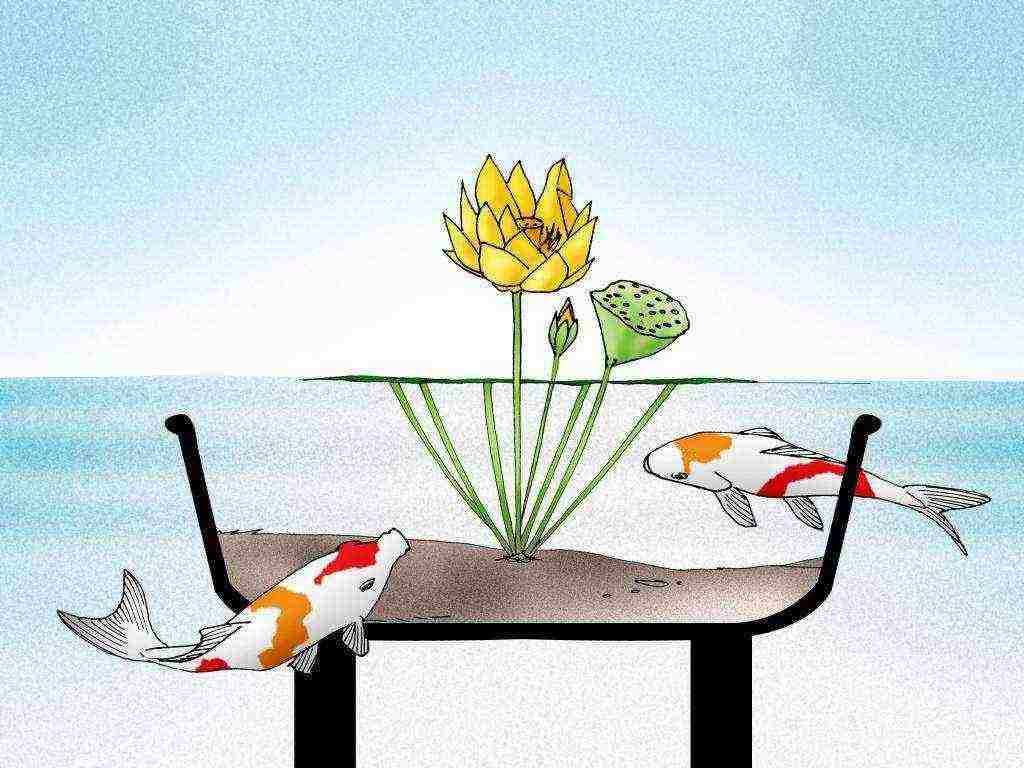
You should pay attention to plant feeding. If it is in a natural reservoir, then there should be no problems in this matter. But if it is in a special dish or container, then it will be necessary to add manure to the ground.
The lotus can be killed by algae that can grow in the pond. They lead to water bloom. That is why it is necessary to regularly monitor the water in the reservoir and use special tools that can cope with such a problem.
In addition, you need to pay attention to the fact that this plant loves light. Therefore, it needs to be grown only in a bright place. With the right temperature and good light, lotus flowers can delight their owners all year round.
Plant care
It is important to pay attention to how the plant should be looked after. This is due to the fact that its further growth will depend on this very moment.
For such a plant, you need to choose a large pot. An open reservoir is also an excellent option. But this option is available to fewer people.
You should pay attention to the fact that the plant may face such a problem as pests. They can lead to diseases of the lotus or its death. Therefore, you should take care of special means for processing the leaves. But they can be used only in accordance with the instructions, so as not to harm the plant.
For example, aphids can simply be washed off the leaves of a plant with plain water. But with other pests it is better to fight more radically.
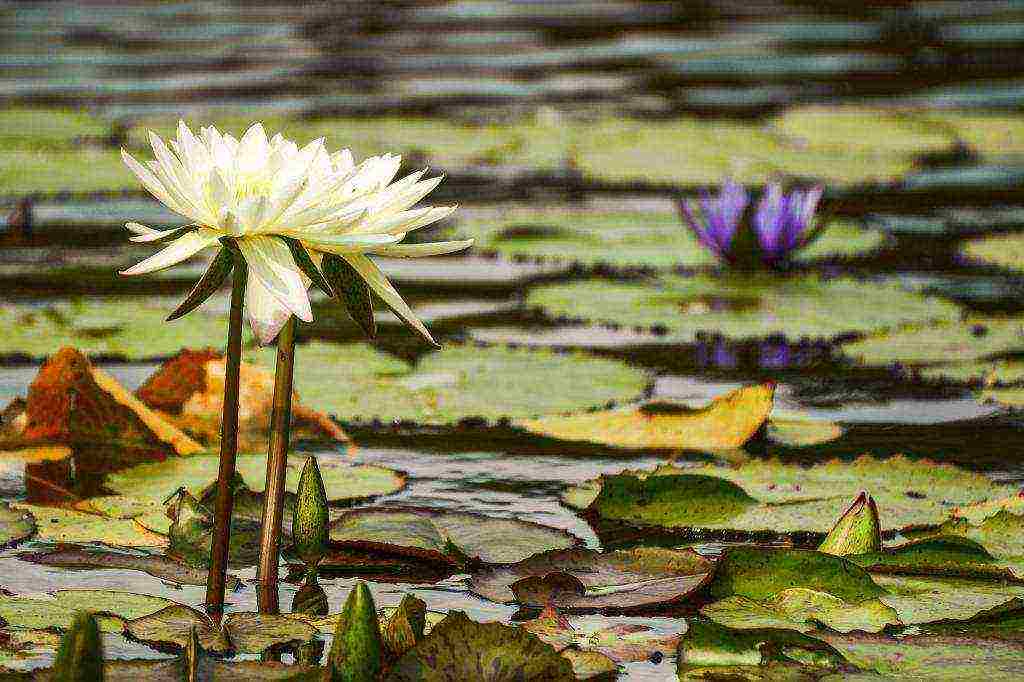
When planting a plant, it is important to pay attention to the fact that its leaves are not completely covered with water. Otherwise, it can lead to his death.This is an important point that should not be forgotten. This information helped to understand how to grow a lotus at home.
conclusions
Growing a lotus from seed at home is not as difficult as it seems at first glance. The main thing is to know what to do and follow all the recommendations given in the article. Then soon it will be possible to observe the first results. A pond or body of water will become a source of pride for its owners. All friends and relatives will come here to see the beautiful white aquatic plant.
It is important to pay attention to the main points. Lotus loves:
- warmly;
- water;
- light.
It must be remembered that at low temperatures the plant can die. To prevent this, you need to immediately find a place suitable for the lotus in the apartment or near the house.


